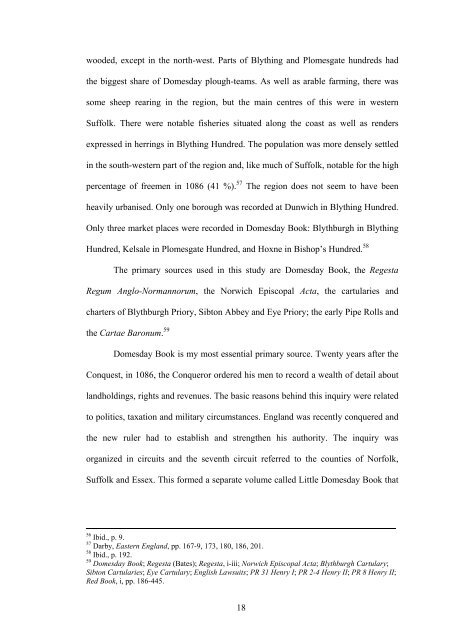I certify that I have read this thesis and have ... - Bilkent University
I certify that I have read this thesis and have ... - Bilkent University
I certify that I have read this thesis and have ... - Bilkent University
You also want an ePaper? Increase the reach of your titles
YUMPU automatically turns print PDFs into web optimized ePapers that Google loves.
wooded, except in the north-west. Parts of Blything <strong>and</strong> Plomesgate hundreds had<br />
the biggest share of Domesday plough-teams. As well as arable farming, there was<br />
some sheep rearing in the region, but the main centres of <strong>this</strong> were in western<br />
Suffolk. There were notable fisheries situated along the coast as well as renders<br />
expressed in herrings in Blything Hundred. The population was more densely settled<br />
in the south-western part of the region <strong>and</strong>, like much of Suffolk, notable for the high<br />
percentage of freemen in 1086 (41 %). 57 The region does not seem to <strong>have</strong> been<br />
heavily urbanised. Only one borough was recorded at Dunwich in Blything Hundred.<br />
Only three market places were recorded in Domesday Book: Blythburgh in Blything<br />
Hundred, Kelsale in Plomesgate Hundred, <strong>and</strong> Hoxne in Bishop’s Hundred. 58<br />
The primary sources used in <strong>this</strong> study are Domesday Book, the Regesta<br />
Regum Anglo-Normannorum, the Norwich Episcopal Acta, the cartularies <strong>and</strong><br />
charters of Blythburgh Priory, Sibton Abbey <strong>and</strong> Eye Priory; the early Pipe Rolls <strong>and</strong><br />
the Cartae Baronum. 59<br />
Domesday Book is my most essential primary source. Twenty years after the<br />
Conquest, in 1086, the Conqueror ordered his men to record a wealth of detail about<br />
l<strong>and</strong>holdings, rights <strong>and</strong> revenues. The basic reasons behind <strong>this</strong> inquiry were related<br />
to politics, taxation <strong>and</strong> military circumstances. Engl<strong>and</strong> was recently conquered <strong>and</strong><br />
the new ruler had to establish <strong>and</strong> strengthen his authority. The inquiry was<br />
organized in circuits <strong>and</strong> the seventh circuit referred to the counties of Norfolk,<br />
Suffolk <strong>and</strong> Essex. This formed a separate volume called Little Domesday Book <strong>that</strong><br />
56<br />
Ibid., p. 9.<br />
57<br />
Darby, Eastern Engl<strong>and</strong>, pp. 167-9, 173, 180, 186, 201.<br />
58<br />
Ibid., p. 192.<br />
59<br />
Domesday Book; Regesta (Bates); Regesta, i-iii; Norwich Episcopal Acta; Blythburgh Cartulary;<br />
Sibton Cartularies; Eye Cartulary; English Lawsuits; PR 31 Henry I; PR 2-4 Henry II; PR 8 Henry II;<br />
Red Book, i, pp. 186-445.<br />
18
















